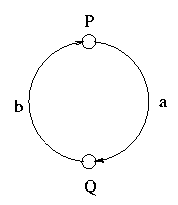1. P =def= a.b.P + a.c.P
2. P =def= a.(b.P + c.P)
3. P =def= Q | R where Q =def= a.Q and R = b.R
4. P =def= Q | R where Q =def= a.Q and R =def= ^a.R
5. P =def= (Q | R)\{a} where Q =def= a.Q and R =def= ^a.R
6. P =def= (Q | R)\{a} where Q =def= a.Q + b.Q and R =def= ^a.R + c.R
7. P =def= Q [a|->c] where Q =def= a.b.Q
Give a finite representation of the transition graph whenever possible. For instance,
if the process is P =def= a.Q and Q =def= b.P, then the graph should be:

1. P =def= a.0 + a.P , Q =def= a.(0 + Q) 2. P =def= a.0 + tau.P , Q =def= a.0 3. P =def= a.(P | P) , Q =def= a.a.Q 4. P =def= a.tau.c.0 + a.tau.d.0 , Q =def= a.(tau.c.0 + tau.d.0) 5. P =def= a.R | ^a.0 , Q =def= a.^a.R + ^a.a.R + tau.R
In the last pair, ^a represents the action complementary to a. (according to our convension, a is input and ^a is output).
B2 =def= in.B1 B1 =def= in.B0 + ^out.B2 B0 =def= ^out.B1Consider now the implementation of a two-position FIFO buffer by using two one-position buffers, serialized, and communicating via the adjacent ports:
C =def= (B[out|->a] | B[in|->a])\{a}
where B is defined as follows:
B =def= in.^out.BSay whether B2 and C are strongly / weakly bisimilar or not. Justify your answer.